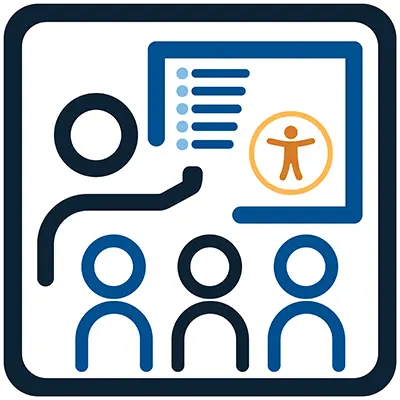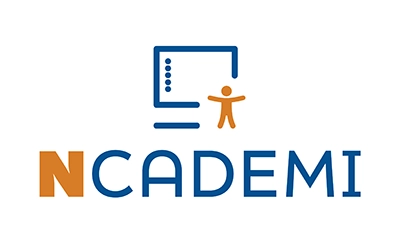
Statement
State and local educational agencies (SEA and LEAs) provide or arrange for coordinated, sustainable training and support that builds the capacity of all staff to meet their responsibilities related to digital accessibility.
Intent
All agency staff involved in evaluating, procuring, selecting, creating, and using digital educational materials are provided with the necessary knowledge, support, and resources to effectively carry out their roles. Training matches specific roles with appropriate tools and techniques. To minimize cost and duplication of effort across LEAs, the SEA coordinates learning opportunities and resources with federally and state-funded partners.
Critical Components
To effectively address Quality Indicator DM5, the following components should be present:
DM5.1 Integrated into Professional Development
Digital accessibility is appropriately integrated into all relevant professional development (PD) priorities, including the use of high-quality instructional materials and edtech in subjects across the curriculum.
DM5.1 Self-Assessment Scoring Matrix
| Not Started | Emerging | Operationalizing | Scaling & Sustainability |
|---|---|---|---|
| The need to integrate digital accessibility into PD priorities has not yet been considered or is limited to special education. | The SEA and LEAs (“the agency”) are reviewing current PD priorities and identifying where digital accessibility naturally aligns (e.g., curriculum adoption, instructional design, edtech integration). Planning is underway to embed accessibility principles into these existing initiatives. Coordination between curriculum, tech, and special education leaders is underway. | The agency integrates accessibility concepts into some existing PD offerings (e.g., accessible design during curriculum training, guidance on evaluating edtech tools). PD facilitators begin referencing accessibility as a standard part of instructional quality. Educators are introduced to connections between accessibility and effective teaching practices. | Digital accessibility is a consistent, intentional component of all relevant PD priorities—especially those focused on instructional materials, curriculum planning, and technology use. It is not treated as a separate topic but as fundamental to instructional effectiveness and quality. PD facilitators are trained to model accessible practices, and accessibility is part of evaluation and follow-up support. |
The scoring matrix is part of the Quality Indicator Self-Assessment Tools.
DM5.2 Role-Specific Training
Training is differentiated by staff role and responsibilities, including digital accessibility in:
- Instructional materials review
- Procurement
- Teacher selection of supplemental curriculum materials
- Teacher creation of learning materials
DM5.2 Self-Assessment Scoring Matrix
| Not Started | Emerging | Operationalizing | Scaling & Sustainability |
|---|---|---|---|
| The need for differentiated accessibility training by staff role and responsibilities has not yet been considered. | The SEA and LEAs (“the agency”) are identifying key staff roles involved in the selection, procurement, and creation of digital educational materials. Planning is underway to define what each role needs to know and do to support accessibility. Staff are coordinating to develop job-specific learning objectives, training outlines, or role-based modules. | The agency offers job-specific accessibility training for multiple staff roles (e.g., procurement, curriculum review teams, instructional staff), aligned to their specific responsibilities. Training content includes varied resources, such as use cases, decision-making tools, and guidance tied to job functions. Feedback is gathered to refine and expand offerings to additional roles. | Digital accessibility training is differentiated and routinely delivered based on staff roles. Procurement, instructional design, curriculum selection, and classroom content creation each have tailored learning pathways. Expectations are aligned with staff responsibilities, and systems are in place to onboard new personnel and refresh training over time. |
DM5.3 Accessible Training Materials
Training materials are exemplars of digital accessibility, modeling best practices for providing accessible content.
DM5.3 Self-Assessment Scoring Matrix
| Not Started | Emerging | Operationalizing | Scaling & Sustainability |
|---|---|---|---|
| The need for accessible training materials has not yet been considered. | The SEA and LEAs (“the agency”) are reviewing current training materials to identify accessibility gaps (e.g., missing alt text, unreadable slides, lack of captions). Planning is underway to adopt accessibility checkpoints in the PD development process. PD facilitators are learning how to apply accessibility principles to their content. | Some training materials provided by the agency demonstrate digital accessibility best practices (e.g., slide templates with proper heading structure, videos with captions, documents with accessible formatting). PD facilitators are using accessibility checklists, and internal reviews are helping to improve quality. Staff begin to understand the accessibility practices being modeled. | All training materials provided or shared by the agency model digital accessibility, including consistent use of accessible templates, media, and documents. Accessibility reviews are part of the standard PD development process. Training not only teaches accessibility—it embodies it. Materials are regularly updated to reflect evolving standards and staff feedback. |
DM5.4 Leverage Existing Training Resources
Federally and state-funded training and TA resources are leveraged for evidence-based content and cost savings, including the state’s AT Act Program and the National Center on Accessible Digital Educational Materials & Instruction (NCADEMI).
DM5.4 Self-Assessment Scoring Matrix
| Not Started | Emerging | Operationalizing | Scaling & Sustainability |
|---|---|---|---|
| The need to leverage federally and state-funded resources to support digital accessibility has not yet been considered. | The SEA and LEAs (“the agency”) are identifying relevant federally and state-funded accessibility resources and technical assistance providers. Staff have been assigned to initiate contact with the state’s AT Act Program and NCADEMI about available training and TA, as well as recommendations for additional support related to the agency’s digital accessibility priorities. | The agency has begun using external TA center content and training modules to supplement internal PD. Select staff participate in webinars, learning communities, or consultations offered by NCADEMI, the AT Act Program, or other available organizations. Resources such as publications, accessibility rubrics, checklists, or training modules are shared with staff. Efforts are underway to align these resources with state and local goals. | Federally and state-funded TA resources are systematically integrated into the agency’s PD strategy. Trainers use and adapt external materials for local implementation. The agency maintains active partnerships with TA providers and routinely updates internal resources using vetted, evidence-based tools. These collaborations strengthen quality, sustainability, and cost efficiency. |
DM5.5 Training Material Repository
A centralized online repository of resources and archived training materials is maintained to stay current with accessibility standards and tools used by the agency.
DM5.5 Self-Assessment Scoring Matrix
| Not Started | Emerging | Operationalizing | Scaling & Sustainability |
|---|---|---|---|
| The need for a centralized online repository of resources to stay current on accessibility standards and tools has not yet been considered. | The SEA and LEAs (“the agency”) are identifying existing training materials, accessibility tools, and reference documents that should be organized into a shared repository. Teams are planning the structure, access points (e.g., internal website or learning platform), and update procedures. Accessibility and usability of the repository itself are part of the planning process. | The agency provides a centralized online repository that includes key guidance documents, recorded trainings, tools, and resources related to accessibility. Content is curated in alignment with current agency-supported tools and platforms. Staff are encouraged to use and contribute to the repository. Feedback is being collected to inform development. | The agency’s online repository is a go-to source for current, relevant, and accessible training materials and guidance. It is maintained on a regular schedule and reflects updates to accessibility standards (e.g., WCAG updates), edtech platforms, and instructional practices. Staff rely on it to access on-demand support, and feedback mechanisms inform ongoing improvement. |
DM5.6 Designated Support Role
A designated digital accessibility coordinator(s) or team is named for staff to request technical assistance and provide feedback on agency-provided resources and professional development.
DM5.6 Self-Assessment Scoring Matrix
| Not Started | Emerging | Operationalizing | Scaling & Sustainability |
|---|---|---|---|
| The need for a designated digital accessibility coordinator(s) or team has not yet been considered. | The SEA and LEAs (“the agency”) are planning how to designate and support one or more staff members or team as the main point of contact for digital accessibility assistance and feedback. Roles, responsibilities, and procedures for intake and follow-up are being defined. Staff are being consulted about their support needs. | The agency has designated a digital accessibility coordinator(s) or team, and staff are informed of how to reach them. The coordinator(s) or team is responding to requests for support with accessibility practices, resources, and PD. A process for tracking inquiries and collecting feedback on accessibility challenges is in use or being tested. | The agency’s designated coordinator(s) or team is a well-known and trusted resource within the agency. Staff routinely reach out for assistance and provide feedback through established channels. The coordinator(s) or team routinely communicate with leadership to address recurring issues, update resources, and support training. The digital accessibility coordinator role is integrated into the agency’s PD and technical support systems. |
